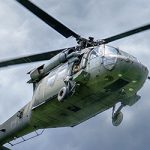2019 MSPO Preview: Expected CEE Modernization Directives
The upcoming International Defense Industry Exhibition ‘MSPO’ in Kielce, though focused on the Polish Armed Forces’ (PAF), also provides an opportunity to assess the progress of the defense modernization agenda across Central and Eastern Europe (CEE).
Last year brought 624 companies from 31 countries, all of whom are interested in becoming providers for the region’s modernization programs. For this MSPO, taking place between 3 and 6 September, organizers expect another record-level of attendance by exhibitors and visitors. This level of interest is to be expected given that the CEE represents one of the fastest growing military markets in the world
In fact, the CEE’s cumulative defense spending will reach $191 billion over the next five years, growing on average by 4.8% each year as CEE defense spending rises from $28.1 billion today to a projected $35.5 billion in 2024. Of interest to international contractors will be the fact that over a quarter of that total, $52.9 billion, will be spent on the procurement of defense hardware.
Progress of CEE countries towards defense modernization
Poland leads the CEE by a significant margin when it comes to military funding. Over the next five years Poland is projected to represent 42% of all CEE defense spending – and 38% of all CEE procurement.
However, Poland is till challenged when it comes to the implementation of its impressive defense modernization agenda. As a consequence of a relatively limited defense budget in comparison to the modernization requirements, Poland has procured comparatively small quantities of modern weapon systems while, in many cases, continuing to upgrade aging ex-Soviet military hardware.
Poland procured just two out of eight planned mid-range air and missile defense batteries within the Wisla program, one out of three divisions of rocket artillery systems under the Homar program, and merely eight (4 S-70i Black Hawk and 4 AW101) out of about 100 required helicopters.
At the same time, the Ministry of National Defense (MND) also decided to upgrade 318 T-72 main battle tanks (MBTs), instead of procuring new tanks.
The MND announced the long-delayed Technical Modernization Program (TMP) 2017-2026 at the end of February. Harpia combat aircraft, Kruk attack helicopters, and Narew short-range air defense system (SHORAD) programs were listed as the top three priorities. However, the Defense Minister Mariusz Blaszczak has already declared that a new TMP, which will reach out to 2035, will be approved in September.
The new TMP should reaffirm the ongoing modernization priorities such as Harpia, Kruk and Narew and provide guidance regarding the implementation of the second phase of Wisla program, the acquisition of new MBTs and the scope of Navy modernization.
Despite setting up a new TMP, the general lack of progress in execution thus far when it comes to Poland’s massive defense needs suggest that modernization will likely remain scattershot.
Romania is the second-biggest defense spender in the region, spending 17.2% and 21.1%, respectively, of cumulative CEE spending on the armed forces and investment. Among CEE countries Romania stands out for its methodical and consistent approach implementing its modernization agenda
Romania has recently chosen the joint offer of Naval Group and Romanian Santierul Naval Constanta (SNC) shipyard to build four modern Gowind-class corvettes and modernize its T22 frigates. The program, which costs almost $1.4 billion, is the biggest naval contract in CEE and will significantly boost Romania’s deterrent posture in the Black Sea.
Due to original plans to keep a single anti-ship missile for all naval related modernization programs, the corvette selection strongly points to MBDA being chosen to be the missile supplier for the coastal defense units. In the coming years major modernization decisions will be limited to an award for Short Range Air Defense (SHORAD) and selecting suppliers for attack and utility helicopters.
As a member of the European Defense Agency projects,[1] Romania is very likely to choose the Leopard 2 as its next Main Battle Tank (MBT).
Hungary has made remarkable progress in its defense modernization efforts recently, better than any other CEE country. At the end of 2018, the MoD ordered 16 H225M helicopters with the HForce weapon system.
It was a second contract for Airbus Helicopters in Hungary within six months. The previous contract was for 20 H145M platforms signed in June. Hungary also procured 44 Leopard 2 A7+ MBTs, 12 second-hand Leopard 2 A4 MBTs for training and 24 PzH 2000 self-propelled howitzers from Krauss-Maffei Wegmann (KMW).
All these contracts are part of Hungary’s ten-year Zrinyi 2026 military development program. Additionally,
At this time a US firm appears to be the leading candidate.
The Czech Republic has also accelerated the implementation of the defense modernization agenda and recently signed contracts for the delivery of TITUS 6×6 vehicles, the acquisition of additional CASA 295 transport aircraft, the upgrade of T-72M4CZ MBTs and selected UH-1Y/AH-1Z platforms as its new attack/multi-role helicopters.
However, the MoD has yet to finalize the long-awaited programs such as tracked infantry fighting vehicles and 3D multi-mission radars. Additionally, the full modernization list is much longer and covers artillery and unmanned systems, SHORAD, command and communications vehicles, light tactical vehicles, and upgrades of combat aircraft and wheeled IFVs.
Further progress on defense modernization depends on the future of the fractious governing coalition. The minority government led by Andrej Babiš may struggle to build the broad political consensus necessary to implement a complex and costly defense modernization agenda.
Slovakia has sealed a contract for new F-16 Block 70/72 fighters and the MoD recommended procuring 17 3D medium, short and very short-range radar systems from Israel. The Ministry also wanted to initiate a tender for 4×4 multirole tactical vehicles but it was forced to suspend the procurement by the Office for Public Procurement due to an ongoing review of the tender evaluation procedure.
The MoD will most likely restart the procedure for 4×4 vehicles next year after all procedures are reviewed. Slovakia may also procure additional UH-60M Black Hawk helicopters, as it received $50 million for helicopter acquisition within the European Recapitalization Incentive Program (ERIP), granted by the US State Department. Slovakia’s other short-term modernization priorities are new anti-tank missiles and modernization of T-72 MBTs fleet.
Bulgaria joined Slovakia in selecting the F-16 Block 70/72 for its Air Force, buying eight aircraft for $1.26 billion in a one-time payment. To make room for the F-16 acquisition, the other modernization priorities including the acquisition of 8×8 military vehicles (in IFV and APC configuration) and new modular patrol ships will most likely only start being implemented in 2020.
The Baltic states have all made substantial progress in their modernization efforts:
- Latvia bought four UH-60M Black Hawk helicopters and Penguin unmanned aircraft systems (UAS); a tender is expected for 4×4 tactical vehicles.
- Estonia joined the Spike family, acquiring Spike LR anti-tank missiles and RQ-20B Puma UAS; efforts may intensify to acquire medium-range air defense systems.
- Lithuania procured additional AMRAAM missiles for its NASAMS air defense systems and declared its intentions to buy Joint Light Tactical Vehicles (JLTV).
This recent surge in modernization activity makes it very unlikely that Baltic nations will have defense funding available to pursue any big-ticket programs.
Western Firms Angle for CEE Business
After Slovakia’s and Bulgaria’s selection of F-16 and Poland’s declared intent to procure the F-35, Lockheed Martin cemented its position as the main provider of combat aircraft for the region.
Within the last twelfth months, Lockheed Martin also secured contracts for Black Hawk helicopters to Latvia and Poland, and for the HIMARS rocket artillery system to Poland.
President Andrzej Duda’s successful visit with President Trump in Washington, D.C., which produced a Joint Declaration in addition to an F-35 fly-over during the signing ceremony, portends well for the competitive position of Lockheed Martin and other American companies in Poland.
However, even in pro-American Poland, the trade unions articulate their disapproval of sending money and jobs across the Atlantic to procure US made systems. Business as usual, in which CEE countries simply purchased US military equipment without substantial offsets or industrial participation, is no longer a sustainable model for American firms in the region.
Participation by local companies will become an increasingly important factor in the awarding of military contracts. US companies will need to change their approach to CEE customers in terms of work-sharing and transfer of technology. Otherwise, US firms’ risk that their market position may decrease over time due to more enticing industrial collaboration offers provided by Western European A&D suppliers.
Most of the European A&D companies, with the exception for Airbus, KMW and Naval Group, cannot count the last year as successful in terms of CEE defense contracts. These companies are aware of the growing influence of US suppliers in the region and are looking to mitigate American advantages.
European firms will differentiate their offerings by proposing technology and work-sharing transfers as well as the integration of CEE defense companies into their supply chains. Additionally, they will soon get a new tool to compete with US companies.
The European Defense Fund (EDF)[1], with an expected budget of €13 billion, can be used by the Western European firms as an instrument to secure and cultivate long-term cooperation with local defense firms and to guarantee a sustained presence in the CEE market.
The EDF, along with the Permanent Structured Cooperation (PESCO), serve as a political and structural umbrella for deepening defense industry collaboration and acquisition will challenge US companies in the CEE market in the medium to long-term.
Conclusion of the 2019 MSPO Preview
Over the last year, the CEE countries made progress in their defense modernization efforts. The key procurement decisions were mainly positive for US companies.
However, if American firms want to sustain their role as prime suppliers of defense hardware in the region, they should press the US authorities to either relax the tech transfer policy rules or to increase subsidizing defense sales by expanding the ERIP available to CEE countries.
The ideal scenario, which would combine both options, seems rather less probable due to the US’s tradition of tech transfer restrictions. Consequently, the ERIP expansion seems to be the immediate tool to support the sale of US defense hardware in the region.
Otherwise, the position of US firms will be dwindling over time due to more comprehensive defense and industrial collaboration offerings provided by the Western European A&D suppliers.
CEE countries are confronted with an uneasy task to find a right balance between best-in-class defense capabilities associated with US companies and the domestic political support that will follow the in-depth industrial cooperation and other financial incentives provided by Western European firms.
How CEE countries reconcile these competing imperatives will determine both their defense capabilities and viability of local defense firms over the long term. This year’s MPSO will be a great opportunity to assess the most modern defense solutions, exhibited by military suppliers for CEE customers.





